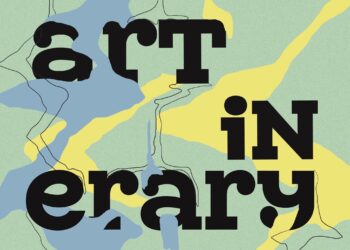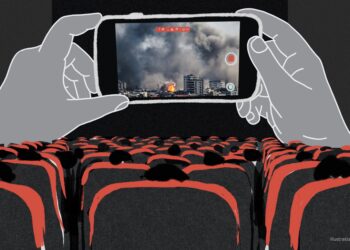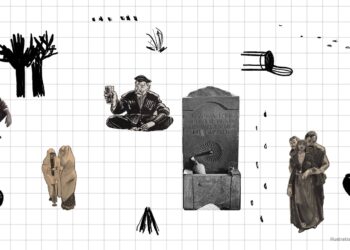
Listen to the article
Armenia has seen a rapid development of festivals during the last decade. The large number of gastro, wine, and craft festivals in the country’s regions paved the way to the creation of “FestivAr“, the Association of Armenian Festivals in 2018. In parallel, film, media, music, architecture and contemporary art festivals initiated by different creative communities sprouted in the capital and in rural areas fostering economic and social revitalization and collective empowerment. Since the aftermath of the 2020 Artsakh war, such collective and artistic manifestations – experienced by the public in a condensed timeframe – also play an important role in strengthening community bonds, reinforcing solidarity and resilience, and providing a safe space for expression to confront the ongoing crisis we’re living in and cope with our collective traumas.
Festivals are vibrant platforms that unite people under a common theme, or agenda, fostering encounters, social cohesion, while activating the host space in which they take place. However, when poorly conceived and managed, they risk undermining these very values, raising critical questions about their intentions and impact.
The Total Drama Festival initiated by Electric Architects architecture firm as part of a twelve-months-program run by the one-year-old Library for Architecture took place in Yerevan in June 2024. Electric Architects collaborated with RAMBALKOSHE contemporary art museum to organize the festival’s first act from May 31st to June 2nd, framed under the “musæum” project RAMBALKOSHE initiated last year. These independent entities together took over a 5000m2 building on Levon Khechoyan Street in the Arabkir district of Yerevan, over the course of three days. Dozens of artists, collectives, studios, brands, and shops were invited to “dive in a unique experience of a theatrical adventure between space and volume” as the organizers state. The festival was announced on social media a week before the opening, mentioning the engaged artists, the address, the monumental size of the space, and the name “ATS”. Naturally, many of us were curious as to which massive building we were going to discover and how the artists engaged with it.
The three of us came to the opening event independently, yet, when we met in the space, we shared a common feeling of dissonance and disturbance on some aspects of the festival. It was quite startling to learn that the “ATS” building, the space in which the festival was taking place, was slated for demolition immediately after the event, and that the event was sponsored by the same company responsible for its destruction. The following paragraphs are not in any way meant to disregard the artists and the artworks exhibited. On the contrary, our reflections are aimed to initiate a dialogue about our concerns regarding the curation and engagement of this festival (among many others) with heritage spaces and the public, and the ethical implications that result from it.
Commitment to Creative Repurposing?
Heritage sites in state of abandonment dating back to the modernist as well as previous periods are scattered around Armenia. Under state or private ownership, many of these sites are exciting spaces to inhabit and revitalize for any practitioner in the creative sector. Yet, the excitement comes with a responsibility for critical engagement: how does one tackle the state of abandonment of the built environment without romanticizing the state of ruin? How does one propose a creative intervention that respects the historical context and integrity while creating vibrant, joyful, and meaningful encounters and experiences for contemporary audiences? Organizing a creative endeavor in an abandoned heritage site is challenging enough; doing so on a site destined for immediate demolition, with the real estate development agency financing the event, calls for serious reflection.
Indeed, while the Total Drama Festival aimed to bring art and people to a neglected space, the public (mostly unaware) unconsciously became a mere spectator of a building soon to be vanquished. As a result, numerous concerns about the intersection of art, heritage, and real estate development arise. Instead of engaging critically with the state-of-affairs of real-estate development in the country, or advocating for the creative repurposing of the building, the organizers and artists became tools for the real-estate developers sponsoring the event. As such, the festival became an event that used the abandoned site as an atmospheric backdrop for artistic expression, while helping to reframe the developer’s actions in positive light. Using such abandoned modernist buildings as mere backdrops commodifies the space for spectacle and entertainment. By focusing on the visual appeal of decay, the festival neglected the ethical responsibility to present these spaces in a way that acknowledges their past and current significance. How so?
Contextualization and Integrity
As a festival organized by an architectural studio within the framework of the Library for Architecture’s programming, the latter being an “independent platform for discussing theory and presenting new concepts in architecture,” one would think that the festival would provide its public contextualization about the building and the surrounding environment, engaging the visitors into a deeper understanding of the site’s history. Who were the occupants of the building? What was it used for? Why did they vacate? Why were they located in this neighborhood? We heard by word of mouth during the event that the building mentioned while promoting the festival on social media as “ATS” used to be a telecommunications station for the Arabkir district.
Considering the communication-oriented nature of the building, one would think that this invites for a contextual curatorial position connecting artists, artworks, and communities with the space. Why use the visual allure of the site without deeper engagement with its spatial and historical fabrics? The organizers’ position about the “theatricality of architecture and the spatiality of the theater” as stated in their announcement revealed itself through this building’s sad fate. It was almost as if the nascent demolition was scripted-in as the final, extravagant act of this particular “dramatic” narrative. Without a contextualized engagement, wasn’t the festival simply promoting superficially user-friendly, experience-based art as a joyful and festive experience and Instagrammable moment? Shouldn’t festivals encourage critical thought and debate about the spaces they inhabit, especially when the spaces are charged with history and are on the edge of eradication?
The work of Misak Samokatian is a great example of a meaningful contemporary intervention which aligns with the above-mentioned values: the “light-attack” installation was site-specific and brought forward the unsettling feeling of demolition. A beautiful discovery was the scenographic theatrical models from the Soviet period that brought a layer of history to the festival and ironically highlighted the importance of preservation in a building that would soon cease to exist.
Considerations for Engagement
What perhaps made us most uncomfortable was the main exhibition hall on the first floor of the building. As you entered, the wall on the left bore an information panel regarding the main organizers of the festival. The spacious floor hosted two things: a table in the middle showcasing architectural models, surrounded by a number of swings hanging from the ceiling. The physical maquettes represented the proposed “Sunday Towers”’ residential district being built in lieu of the structure we were in. The table also included brochures advertising the real-estate development project, and if that was not enough of a marketing strategy, an agent approached us to highlight some of the key features of the project, such as a pool on a given floor or the fact that the whole proposed district will be “car-free.” In a city with high congestion, modest public transport infrastructure, it seemed like we were supposed to be pleased by an enclave of high-end private development that does not rely on cars within its perimeters, or has a pool for its privileged residents.
Beyond the lack of any urban context that analyzed and situated the proposed project in its socio-economic surroundings, the way in which the festival’s entertainment agenda and public nature falsely rendered the developers as socially responsible agents was deeply concerning. In the absence of proper stakeholder engagement efforts and community outreach that should accompany any large urban development project, especially if it is situated in a densely populated urban area and involving a demolition, were we expected to be satisfied with a dozen swings?
Were the developers using the allure of art to enhance the appeal of their upcoming project, thus commodifying the cultural experience? Is this event falling into the trap of “artwashing” currently happening all over the world, where art is used to create a veneer of cultural engagement while the underlying motive is profit-driven development? Through word of mouth again, we heard that the new “Sunday Towers” district is being designed by Electric Architects, the festival’s co-organizers. Don’t they become directly complicit in the demolition of the building? Doesn’t the festival become a cynical farewell party (not to say a funeral) to a heritage site?
The Path Ahead
Considering that Electric Architects were not only the co-organizers of the festival but also the architects behind the proposed residential development project, isn’t such a festival the perfect space to showcase the urban analysis, preliminary sketches and creative process of the team prior to reaching the final proposal printed in the marketing catalog of the development company? Presenting stand-alone architectural models as kind of decontextualized “ready-made” for a residential project in the heart of the city risks not only omitting the urban context that supposedly gave birth to the project, but also reducing the discipline of architecture and urban design to the mere production of commodified objects and sites that are divorced from their surrounding reality.
Was the organizers’ choice to invest time and resources into an event at a site with no potential for cultural economic growth justified? With many threatened historical sites in Yerevan, festivals like this have the potential to create new cultural narratives and socio-economic infrastructures, saving these sites from neglect and preserving them for future generations.
As we witness a worldwide trend where “fast art” and experiential entertainment dominate the cultural landscape over works with deeper engagements with places, people, and histories, we must reflect on our role in society. Isn’t it the responsibility of artists, curators, architects, and urban planners to be the voice of the voiceless, while also creating, inspiring, and advocating for the public good? How can we balance these aspects to ensure that art remains both enjoyable and meaningful?
Although in today’s context of ongoing crises, one would wish to have spaces of joy, play, and relief, which this festival generously offered, the social responsibility of the creative community remains key to any sustainable and enduring positive change we all want to see in society. We hope these reflections will only be received as an invitation for dialogue to collectively engage with each other and embrace the spaces we inherited and inhabit with care and meaning.
ARTINERARY: June 25-July 5
Yerevan's social calendar is ramping up with a torrent of events that will immerse you in all sorts of art if you, well... let it. To help you navigate the vibrant art scene, we're putting together a short bi-weekly digest of the best that the capital has on offer for the art-going public and visitors.
Read moreEt Cetera
Culture in the Time of Real Estate Wars
Why has the Armenian Government initiated a controversial takeover bid of the Writers' and Artists' Union properties and what does it mean for the wider cultural sector? Vigen Galstyan explains.
Read moreThe School Textbook and the Ghost of Stalinism
Armenian historical scholarship is attempting to shed its Soviet-Stalinist ideological framework and adopt new methodologies and theories. However, ongoing debates suggest that this transformation will be a lengthy and challenging process.
Read moreFrom Artsakh to Gaza, No One Will Be Free
An Armenian film, “1489” won the Main Jury and the International Federation of Film Critics prizes at the International Documentary Film Festival of Amsterdam in 2023 amid upheaval and controversy that triggered a series of withdrawals and boycotts of the festival for its perceived silence regarding Israel’s invasion of Gaza.
Read moreTwo Films From One Fountain
The juxtaposition of two cinematic adaptations of the same literary work reveals polar perceptions of history, tradition, national culture and lifestyle. And by doing so, it indicates that the boundaries of "Armenian cinema" are much wider than they seem.
Read moreThe Now of Literature, After the War
How does war shape the collective narrative? How have Armenian writers since the 1990s approached the impact of multiple wars? Mariam Aloyan looks at Armenian “war literature” spanning generations and decades.
Read more






